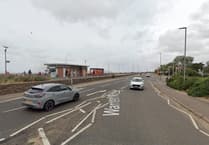THE incredible story of the overland launch of the Lynmouth Lifeboat will be relived on Saturday (January 13) when the 13-mile journey to Porlock is recreated to celebrate the 125th anniversary of a feat which made lifesaving history.
At 7.52 pm on January 12, 1899, the Lynmouth lifeboat crew received a distress call from the Forrest Hall, a 1,900-ton sailing vessel bound for Liverpool with 13 crew and five apprentices on board, and which was in danger of running aground at Porlock Weir.
The violent conditions at Lynmouth made a launch impossible, so coxswain Jack Crocombe proposed a previously unheard-of solution - the lifeboat would be taken overland through the night to launch at Porlock Weir.
To celebrate the epic achievement, a crew of volunteers will haul the Lynmouth Sailing Club safety boat Gilbey from Lynmouth on Saturday, leaving at 7.30 am to negotiate the tricky and winding A39 toward Porlock.
The main challenges on this route will be the vertiginous Countisbury and Porlock hills, both 1 in 4 gradients.
The haul will finish at the Bottom Ship, in Porlock Weir, arriving by 3.30 pm, followed by an afternoon and evening of celebration with folk-punk band Skinny Lister heading the proceedings.
Minehead RNLI community manager Andrew Escott said: “It is wonderful that in the RNLI’s bicentenary year we get to celebrate this impressive lifesaving feat, which will help raise money toward saving lives at sea locally.
“All are welcome to visit the boathouse at Minehead to see how this history has shaped our station.”
On that bitter winter’s night in 1899 it took 40 men and women and 20 horses to manhandle the 10-ton rowing lifeboat Louisa across Exmoor.
Hedges were dug up, ditches filled in, and walls and a cottage demolished to get the seven-foot-wide boat through the narrow lanes.
The lifeboat was finally launched at Porlock Weir at 6 am and stood by the stricken vessel until a tug arrived and escorted her across the Bristol Channel to Barry.
The crew were without food or sleep for 24 hours and were credited with helping to save 18 lives.





Comments
This article has no comments yet. Be the first to leave a comment.